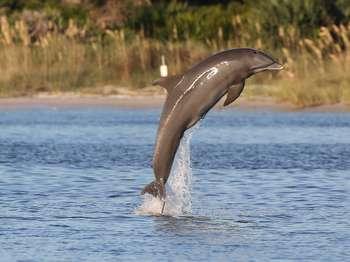Last updated: April 13, 2021
Place
Atlantic Bottlenose Dolphin

Historical/Interpretive Information/Exhibits
Bottlenose dolphins are a relatively common sight in the Matanzas River and in the ocean. They are very social animals and usually congregate together in groups of up to ten members. As with human beings, communication and cooperation are hallmarks of the species. There is a dolphin "language" that consists of noises resembling whistles, whines, groans, and jaw claps. They use their vocalizations to coordinate feeding behavior; sometimes by corralling fish close to shore, making them easier to catch, or by herding schools of fish into a sort of "ball" that then serves as easy prey as each dolphin takes a turn swimming through and grabbing a bite to eat. For anyone who has been to a dolphin show at an aquatic park and seen the amazing tricks and stunts they have been trained to perform, fish ball feeding comes as no big surprise!
Another extraordinary trait dolphins possess is their ability to echolocate using sonar. Using air sacks in their nasal cavities, they make clicking noises that are amplified in a structure called the melon located in their foreheads. These clicks (projected ahead of the dolphin at a rate of up to 2,000 per second!) bounce off objects (such as prey), return, and are funneled to the animal's inner ear and brain by way of the lower jaw. Besides making instantaneous sense of information produced by sonar-echolocation, the dolphin's brain is remarkable in another way. While sleeping, it effectively shuts down one half of its brain while the other half maintains a low level of alertness. In this way the dolphin retains its situational awareness and is able to keep rising to the surface for breaths of air. It will carry on this way for about two hours before switching and resting the other half of its brain. This is quite an evolutionary adaptation on the part of dolphins and other marine mammals which allows them to sleep at sea without drowning!
